by By Ted Levin
The University of Chicago Press, 2016
One day last fall I trailed behind Ted Levin when he went to check up on his snakes. The day was so hot that most were out of sight in cool rock recesses, but even now, recalling the sound of their hidden rattles sets off an alarm deep inside my brain. For a long time we watched a young snake content in the shade of a tree. Even though we didn’t see many snakes, that day on the talus gave me a preview of both rattlesnakes and this book as we walked along. “Here’s where Jordy almost grabbed a snake,” and “Here’s where Alcott sent a boulder the size of a car plummeting down the slope,” and “Here’s where a big black morph walked across my leg.”
America’s Snake somehow gets past what could be an unrelentingly heartbreaking story about human cruelty and ignorance and the near-elimination of a beautiful animal. Learning about the timber rattlesnake’s anatomical adaptations, the reasons it behaves as it does, its precarious survival, and the often really funny stories about many devoted (though sometimes nutty) rattlesnake researchers helps the reader keep hope alive. At first I wondered whether my interest would flag over the course of 440 pages, but that was no problem. During the course of the book, Levin spends days in the field with one biologist after another, dissects a dead snake in his kitchen, and helps take radio transmitters out of six anesthetized snakes in a vet’s office.
The timber rattlesnake is beautifully equipped for survival in a world without humans, but, sadly, much of what the snakes do makes them easy targets of both our malevolent and inadvertent activities. Males travel long distances from their dens to find mates that aren’t from their own family. The almost inevitable road crossings they need to navigate are deadly, especially when a snake pauses to nap on warm tarmac. Settling closest to their nearest relatives, pregnant females congregate to bask at ancestral birthing sites, a bonanza for poachers.
The inability of our species to separate fear of snakes from any real danger may go back a long way. When Charles Darwin brought a stuffed snake into the monkey house at the London Zoo in 1872, he noted that the hair went up on several species of primates.
As Levin explains, despite the fact that rattlesnake venom is used to kill prey and only reluctantly for defense, tall tales about rattlesnake aggression abound, and they aren’t limited to amateurs. John James Audubon, no less, portrayed an anatomically incorrect rattler and in a lecture described one chasing a squirrel in the tree tops and then constricting it (all wrong). He even called a basking site “disgusting.”
The long – or so it seemed to me – chapter about diamondback rattlesnake roundups in the Texas town of Sweetwater is almost too horrible to read. Some members of the human race look pretty disgusting to me during roundup season. The only good thing is that, despite the thousands of diamondbacks that are mistreated, these animals are still abundant.
Except for the tales from Texas, I found the contents of the book fascinating. Tuned to the boom and bust cycles of rodent populations, rattlesnakes can live for a year without food, or can eat every four or five days. When active, they prefer to be at 85-90 degrees and everything they do is driven by the temperature. They have rich social lives, and nearly always return to the same den. They read infrared and follow faint pheromone trails, but don’t see very well.
“Our own attitude toward rattlesnakes is more venomous than the snakes themselves,” writes Levin. After finishing this book, I would modify that. Our attitudes are infinitely more venomous than the snakes themselves. You’ll love this snake and will look for Levin’s next book. But be patient: he spent six years working on America’s Snake.


